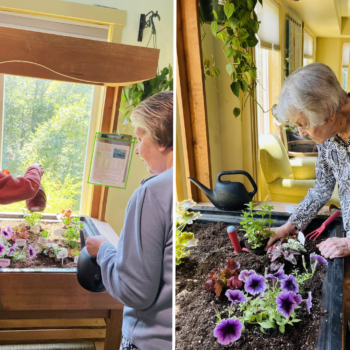
Downsizing Tips For Seniors Transitioning To Senior Living
- Posted by Bainbridge Senior Living
- On November 17, 2023
- senior living, senior living community
Downsizing And Relocation Tips For Seniors Transitioning To a Senior Living Community
Transitioning to a senior living community is a significant life change that often involves downsizing to a more manageable living space. Senior living communities, such as independent living, assisted living, and memory care, offer tailored support, a sense of community, and amenities that cater to the unique needs of older adults. Downsizing for this transition can be a positive step, reducing the burden of home maintenance and providing opportunities for a more socially engaged and worry-free lifestyle.
The amount you need to downsize will depend on the size of your new home and the specific type of senior living community you are moving into. Here are some key types of senior living to consider:
-
Independent Living:
- Independent living communities are designed for seniors who are active and can live on their own but prefer the convenience of services like housekeeping, meal plans, and social activities.
-
Assisted Living:
- Assisted living is suitable for seniors who may need assistance with daily activities such as bathing, dressing, or medication management. It provides a balance of independence and support.
-
Memory Care:
- Memory care is specialized for individuals with Alzheimer’s disease or other forms of dementia. These communities offer a secure and structured environment with trained staff to support residents’ unique needs.
Now, let’s delve into downsizing and relocation tips tailored to seniors making this transition:
-
Start Early:
Begin the downsizing process well in advance of your move to a senior living community. The earlier you start, the less stressful it will be.
-
Set Clear Goals:
Determine what items you want to keep, and what you can give to family members, donate, sell, or discard. Having a clear plan helps streamline the process.
-
Room-by-Room Approach:
Tackle one room at a time. This helps prevent overwhelm and keeps the process organized.
-
Prioritize Sentimental Items:
Begin with sentimental items, such as family heirlooms and photo albums. Take your time with these items and decide what to keep, digitize, or pass down to loved ones.
-
Declutter Ruthlessly:
Be selective about what you keep. Ask yourself if an item serves a practical purpose or brings you joy. If not, consider parting with it.
-
Digitalize Documents:
Scan important documents like legal papers, medical records, and financial statements to reduce paper clutter. Store them securely on a computer or in the cloud.
-
Consider Furniture and Appliances:
Measure the space in your new residence and consider whether your current furniture and appliances will fit. You may need to downsize furniture or opt for smaller, more space-efficient options.
-
Use a Floor Plan:
Obtain a floor plan for your new senior living unit. This can help you visualize where your furniture and belongings will go.
- Packing Supplies:
Gather packing supplies like boxes, bubble wrap, packing tape, and markers. Label boxes clearly with their contents and the room they belong to.
-
Seek Assistance:
Enlist the help of family members or professional organizers who can assist with the sorting and packing process.
-
Plan for Unwanted Items:
Decide in advance how you’ll handle items you’re not keeping. This could involve selling items online or through a garage sale, donating to charity, or arranging for bulk pickup of large items.
-
Embrace Technology:
Consider digital options for books, music, and movies to reduce physical clutter. E-books, digital music libraries, and streaming services can save space.
- E-books:
- Examples: Encourage seniors to transition from physical books to e-books using e-readers like Kindle, Nook, or Kobo. Services such as Amazon Kindle, Apple Books, or Google Play Books provide vast digital libraries with a wide range of genres and authors.
- Benefits: E-books are easily accessible, and readers can adjust font sizes for better visibility. They also eliminate the need for physical bookshelves, reducing the overall space required for a personal library.
- Digital Music Libraries:
- Examples: Instead of storing CDs or vinyl records, seniors can create digital music libraries using platforms like Spotify, Apple Music, or Amazon Music. These services offer extensive catalogs of songs and allow users to create personalized playlists.
- Benefits: Digital music libraries are easily organized, searchable, and take up no physical space. Many services also offer offline listening options, allowing seniors to enjoy their favorite tunes without an internet connection.
- Streaming Services for Movies and TV Shows:
- Examples: Subscription-based streaming services like Netflix, Hulu, Amazon Prime Video, and Disney+ offer a vast array of movies and TV shows. Seniors can access these services on smart TVs, computers, tablets, or smartphones.
- Benefits: By embracing streaming services, seniors can eliminate the need for a collection of DVDs or Blu-rays, freeing up valuable shelf space. Additionally, these services often provide a user-friendly interface, making it easy to browse and watch entertainment content.
- Audiobooks:
- Examples: Audiobook services like Audible offer a convenient way for seniors to enjoy literature without the need for physical books. Audible, for instance, provides a diverse selection of audiobooks narrated by professionals.
- Benefits: Audiobooks are an excellent option for those who may have difficulty reading due to visual impairments. They can be enjoyed during various activities, such as walking, gardening, or relaxing at home, providing a versatile and clutter-free alternative to traditional books.
Encouraging seniors to embrace these digital options not only reduces physical clutter but also opens up new possibilities for entertainment and learning in a more streamlined and accessible way.
-
Manage the Emotional Aspect:
Understand that downsizing and moving can be emotionally challenging. Take time to reminisce about your belongings and say goodbye to your previous home. Seek support from friends, family, or a counselor if needed.
-
Pack Essentials Separately:
Pack a suitcase with essential items you’ll need immediately upon arrival at your new senior living community. Include medications, important documents, toiletries, and a few changes of clothes.
-
Stay Positive:
Focus on the senior living benefits of your move, such as easier maintenance, social opportunities, and a sense of community in your new senior living setting.
-
Ask for Help from Your Senior Living Community:
Contact your senior living community for assistance and guidance in the moving process. They may have resources, moving services, or staff members who can help make the transition smoother.
Remember, downsizing and relocating can be a significant life change, but it can also be a positive step toward a more comfortable and manageable living situation in a senior living community.

Learn More About Bainbridge Senior Living
Discover the difference at Bainbridge Senior Living. Whether you or your loved one is seeking a vibrant community, personalized care, or a supportive environment, we invite you to explore our website bainbridgeseniorliving.com for more information.
Contact us today to schedule a tour and learn how Bainbridge Senior Living can be the next enriching chapter in your senior living journey. Give us a call at 206-842-2500 or fill out our contact form.


